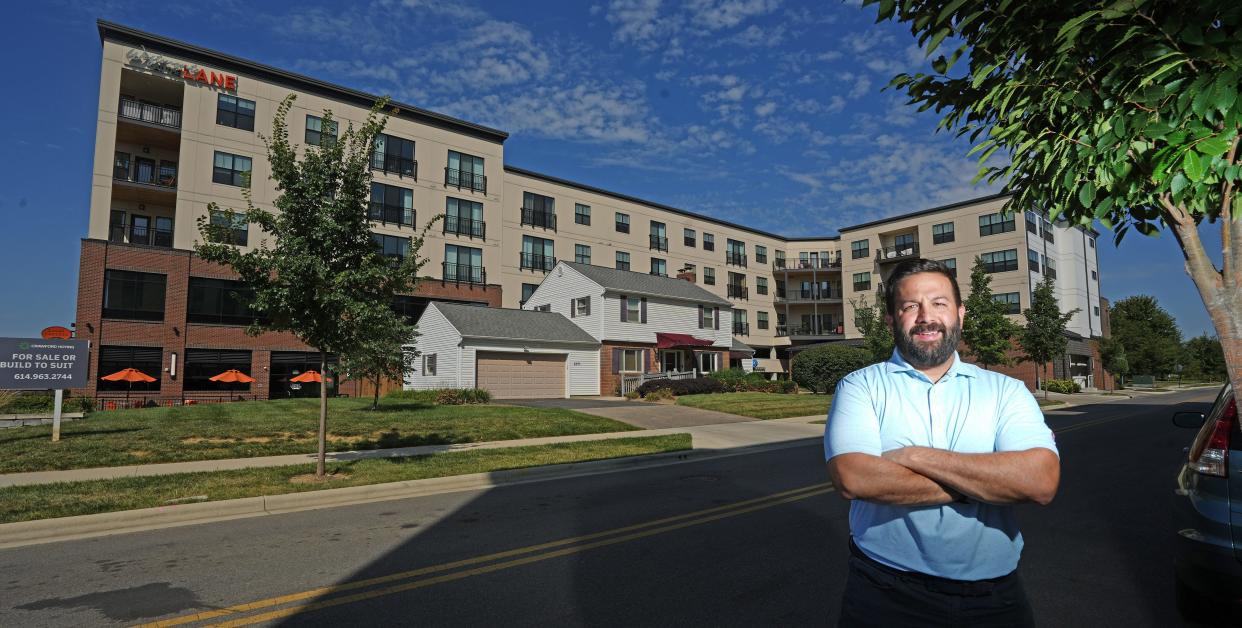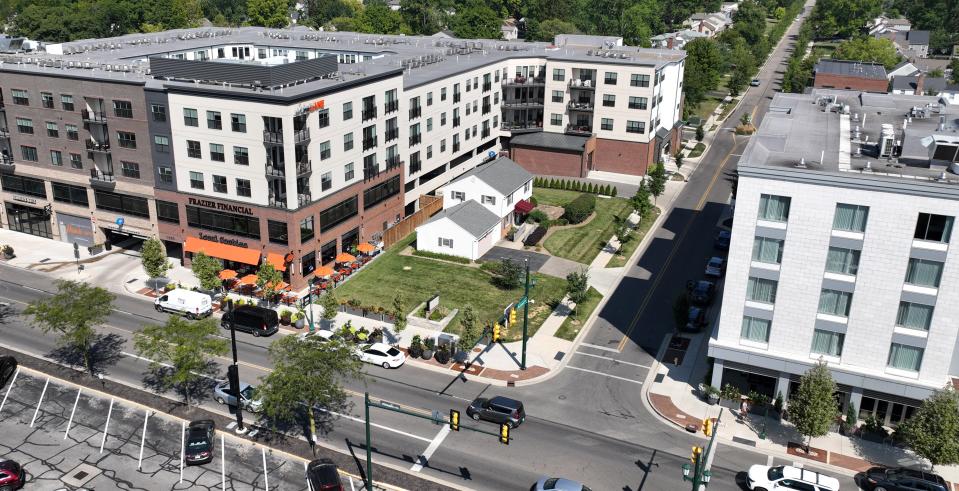Solving the mystery of 'Up'per Arlington's Lane Avenue holdout home

The two-story home along Lane Avenue is the epitome of middle-class life. Built in 1959 with a 2-car garage and three bedrooms, it's got a manicured lawn and shrubs and is move-in-ready.
The only drawback to the Upper Arlington home?
It is surrounded on two sides by 4-story apartments that one neighbor calls "land yachts," and across the street by the 5-story TownPlace Suites by Marriott extended stay motel.
To passersby, it may appear as an illusion. To some, a joke.
Could this misplaced oddity be contemporary art, illustrating the impact of urban sprawl? Satire of the sought-after American dream?
The Dispatch reviewed property records and spoke to neighbors and passersby to learn more.
According to Franklin County property records, 2471 Westmont Boulevard sold in January for $734,000 to 2471 Westmont LLC. Crawford-Hoying real estate now owns it and the surrounding buildings.
Sixteen years before that, the home sold in 2006 for $230,000 to Renee Dutton who eventually set up her State Farm Insurance home office here. An awning still covers the doorway.
According to Chad Gibson, Upper Arlington's community development director, Dutton refused to sell even as Upper Arlington planned big commercial changes along the eastern gateway into the city, including in 2012 the creation of an entertainment district.
"It was a situation where (current owner) Crawford-Hoying Development made a good faith effort to negotiate a fair price. Ms. Dutton did not accept the offer," said Gibson. Based on current commercial real estate prices, Dutton's price for the fifth of an acre corner lot could easily have exceeded $1 million.
But what is more interesting about the time capsule home is the suburban lives of those who lived there, including Strougo and Liza Mordoh, who bought the home in 1990.
Mr. Mordoh, a survivor of the Holocaust, was the sole survivor of Auschwitz from his immediate family. He immigrated to Columbus with Liza and a young daughter after the end of World War II.
"The home was the center of the family," said David Mordoh, Strougo's son, who now lives in Worthington. "It was where many holidays and special events took place."
He recalled staying overnight at the house one night 35 years ago with his wife, Teresa, who kept waking up every 15 minutes to go to the bathroom.

Initially annoyed, the reason became clear. The couple rushed to Riverside Methodist Hospital where their first son, Michael, was born.
Michael recalls visiting his grandfather's bakery, being given treats; his grandmother, always theatrical, created costumes for him and his younger brother.
"For me, it's a lot of memories," said Michael. "Because it's a tangible relic of my grandparents."
Strougo Mordoh passed away in 2009, Liza in 2014. David and Michael think of them often when they passe the home.
"My dad always would say 'One day this is going to go commercial.' He longed for that. He would have really gotten a kick at how that corridor had developed," said David Mordoh.
His father owned an East Side bakery shop and wholesale bakery, before moving Davies Pastry Shop to the former Lane Avenue Shopping Center to be closer to home.
The home has in recent years become known as the "Up house," a reference to the 2009 animated movie about a widower who refused to sell his family home, even as skyscrapers are built around it.
The elder Mordoh wasn't a curmudgeon, however, David Mordoh said. He spoke at schools about the Holocaust and loved people.
According to his 2009 obituary: "Mr. Mordoh continued working until his last day. Upon retirement, he worked part-time at Sam's Club and was known to buy cookies to give to little children; a habit started when he had his own bakery. Strougo Mordoh will be remembered for his strength, loyalty, kindness, sense of humor and Chocolate Babka."
He likely wouldn't have been a holdout, said David Mordoh. But he would have enjoyed the excitement around him. "He would have acted as if he was the governor of Lane Avenue. He would have sat out there and watched the comings and goings and would want to talk to everybody."
That includes those who visit Local Cantina, a bar and restaurant whose side entrance opens onto the home's back lawn.
"I'd hate to live there," said Taylor Smallridge, bar manager, who thought the home was still occupied. "I wouldn't want to live next to a bar."
As for the home's future, "I'd love to have it just stay that way, because there were such happy memories there, especially for my children," said David Mordoh.
Response from the city and Crawford-Hoying indicates that likely won't happen, not even to replace it with a small park or greenspace.
"We've got vitality that the corridor didn't have before," said Gibson, the city's community development director. "We're extremely happy about the positive changes. The entire corridor has seen an amazing rebirth."
"We bought it to demolish and re-develop the site, likely to a small retail/restaurant," wrote Matthew Starr, vice-president of commercial real estate. The timeline and final use has not been determined.
dnarciso@dispatch.com
@DeanNarciso
This article originally appeared on The Columbus Dispatch: Solving the mystery of Upper Arlington's holdout home

